Clivia
BackClivia are one of the best plants to grow in dappled shade beneath trees as they can easily handle the root competition. These tough plants look great with their dark green strappy leaves and clusters of bright, funnel-shaped flowers.
Clivias are perennials that originate from southern Africa and grow via a fleshy rhizome. They are best known for their bright orange flowers but other colours are also available including cream, orangey red and a few bi-colour combinations. Blooms mostly appear in late winter and spring followed by decorative berry-like seeds that change from green to glowing red.
How To Grow Clivia
The commonly grown clivia types are shade loving plants and will burn if exposed to hot sunlight. So it’s best to position them in bright shade. They can handle dark shade but flowering is usually reduced.
Clivias are very adaptable and will grow from Tasmania to the tropics. However they do need protection from frost and extreme cold so think carefully about their position if you live in a region with cold winters.
Plants prefer well-draining soils which have been enriched with plenty of organic matter like compost and aged manures. They can handle poor soils but their growth will be better if you take the time to improve the soil beforehand. In particular if the soil is sandy dig in some clay and organic matter then water in with OCP eco-hydrate as sandy soils are often water repellant.
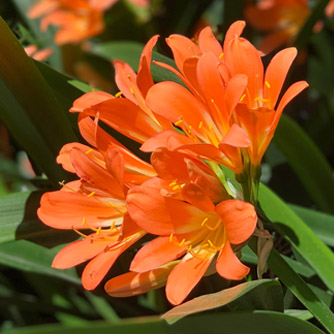
Classic orange clivia flowers
Clivias grow well in containers. Choose a pot large enough to keep them happy for several years as regular repotting may impact on flowering.
Generally clivias will appreciate extra water during spring and summer and can be kept on the dry side during winter.
Fertilising and Maintenance of Clivia
Clivias are often plants that get dropped into a garden bed and then ignored because they’re fairly tough. However they will flower more prolifically when grown in fertile, moist soils so it’s worth showing them a little love. In spring, summer and autumn apply an organic fertiliser or topdress with some compost or manure. In between time treat the plants with a fortnightly dose of OCP eco-seaweed and OCP eco-aminogro. This is especially useful with young plants that you want to clump up quickly.
Once the flowering season is finished, cut back the flower stem unless you want the plant to produce the decorative seeds.
Regularly remove yellow or dead leaves at the base of the plant to keep the plants looking tidy.
Potted plants like being root bound and can be left in the same container for many years. Never leave water in the pot saucer as it can cause root rot.
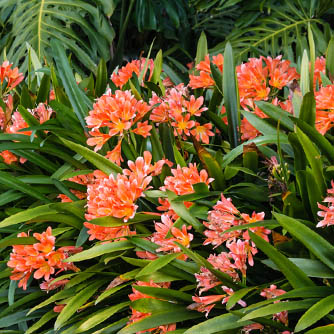
Stunning mass planting of clivias
Propagating Clivia
Plants are usually propagated by division of big clumps once the plants have finished flowering.
Use a sharp spade to dig up plants from the garden or empty out potted plants and then use a sharp knife to divide them further so each piece has roots and leaves. Cut off any damaged roots with sharp secateurs and replant.
Plants can be grown from seed but it is a slow process as plants take 3 to 5 years to grow to flowering size and they may not have the same coloured flowers as their parent plant.
Harvest clivia seeds when they turn red or soften, about six to eight months after the plants have flowered. Open the seed casing, remove the soft pulp and membranes and wash the seeds in water with a drop of dishwashing liquid.
Fill a container with potting mix and place the seeds on top. Press lightly so half of the seed is covered with the mix and then water. Keep the pot in a shady spot and cover with a cloche made from a plastic soft drink bottle. Plants should not be watered again until seed germinates in about three to four weeks.
Fertilise seedlings every two weeks with OCP eco-aminogro and OCP eco-seaweed to maximise their growth.
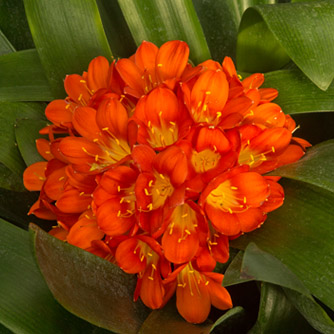
Belgian hybrid clivia with dense flower head and a deeper orange colour
Pests and Diseases of Clivia
- Snails and slugs – both the flowers and foliage are attractive to these slimy pests. Sprinkle OCP eco-shield pellets around for organic protection.
- Mealybugs – these sap suckers congregate between the leaves at the base of the plant. Severe infestation will cause distorted growth. Plants which receive insufficient water in summer seem to be more prone to attack. Spray plants thoroughly with OCP eco-neem. The spray needs to get down into the base so really drench the plant to kill the mealybugs. A follow up spray is strongly recommended a week later given how difficult it is to get good coverage.
- Lily caterpillar – this very hungry caterpillar usually attacks in late summer or early autumn. Seemingly overnight it will strip foliage back to nothing so act quickly and spray with OCP eco-neem.
- Powdery mildew – plants will sometimes get this fungal disease on their foliage which can be controlled with an organic fungicide. Note that plants infested with mealybugs will often have white marks at the base of their leaves which should not be mistaken for powdery mildew.
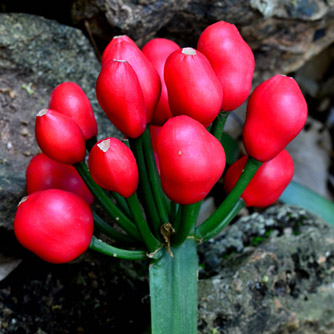
Clivia seed heads will often turn bright red
Types of Clivia
Whilst there are several different species of clivia it is Clivia miniata which is the most readily available. Thanks to breeding over the year there are now many cultivars and hybrids offering orange, cream, yellow and red blooms. In particular the Belgian hybrids, which have broader foliage and deep orange flowers are very popular. Forms with cream flowers are highly prized and are more expensive than orange-flowered plants.
Listed below are the other clivia species but take note that many can be difficult to find in Australia:
- Clivia caulescenshas narrow, pendulous, tubular flowers of coral-red with green and yellow tips in spring. The long leaves can be up to 1.8m long and droop under their own weight.
- Clivia gardenii has tubular-shaped orange to red flowers with a green tip that appear from autumn to spring. Narrow leaves grow to about 75cm long.
- Clivia nobilisis one of the least demanding forms and features pendulous orange tubular flowers with green-tips that bloom in mid winter to spring. Spot flowering at other times can occur. Leaves are often serrated on the edges.
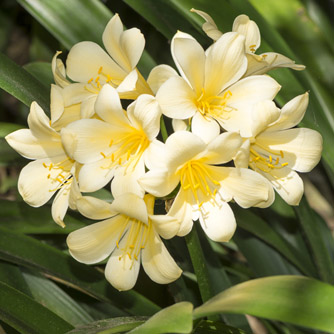
One of the highly prized hybrid clivias with cream flowers
- Clivia mirabilis is a late entrant having only been classified in the early 2000s. It has orange pendulous flowers which appear late spring and early summer. Young leaves have a white stripe down the middle while all leaves have a maroon coloured base. Unlike other clivias this species can handle full sun with just a little protection from hot afternoon sun. It also needs dry summers and winter watering. Perfect drainage is essential otherwise roots will rot.
- Clivia robusta grows to 1.6m in ideal conditions and has pendulous orange flowers with green tips which appear in autumn and winter. It comes from swampy areas so keep the soil moist.
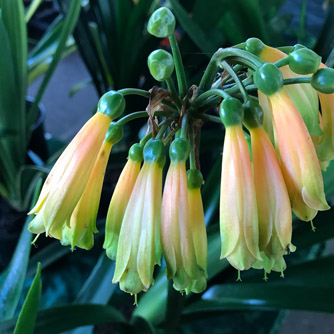
Subtle flowers of Clivia gardenii x robusta hybrid
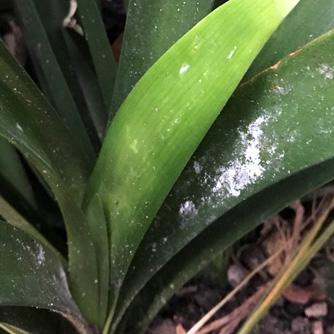
Clivia with mealybug infestation


